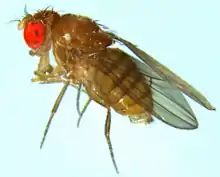Drosophila willistoni
Drosophila willistoni is a species of fruit fly. It was originally described by Alfred Sturtevant in 1916. It ranges from Florida, Mexico and Caribbean islands southwards to Argentina and is the most common Drosophilid fruit fly in the Amazon rainforest.[2]
| Drosophila willistoni | |
|---|---|
 | |
| A D. willistoni female | |
| Scientific classification | |
| Kingdom: | |
| Phylum: | |
| Class: | |
| Order: | |
| Family: | |
| Genus: | |
| Subgenus: | |
| Species group: | willistoni |
| Species: | D. willistoni |
| Binomial name | |
| Drosophila willistoni | |
| Synonyms | |
|
Sophophora willistoni  Illustration of a D. willistoni male | |
This fruitfly is widely used for scientific research, including genetic research.[3][4]
References
- "Drosophila willistoni". Integrated Taxonomic Information System.
- Regner, L. P.; Pereira, M. S. O.; Alonso, C. E. V.; Abdelhay, E.; Valente, V. L. S. (1996). "Genomic distribution of P elements in Drosophila willistoni and a search for their relationship with chromosomal inversions". Journal of Heredity. Oxford University Press. 87 (3): 191–198. doi:10.1093/oxfordjournals.jhered.a022984. PMID 8683096.
- A. Brito da Cunha; Th. Dobzhansky; O. Pavlovsky; B. Spassky (September 1959). "Genetics of Natural Populations. XXVIII. Supplementary Data on the Chromosomal Polymorphism in Drosophila willistoni in its Relation to the Environment". Evolution. Society for the Study of Evolution. 13 (3): 389–404. doi:10.2307/2406115. JSTOR 2406115.
- Therese A. Markow; Patrick M. O'Grady (2005). Drosophila: A guide to species identification and use. London: Elsevier. ISBN 978-0-12-473052-6.
This article is issued from Wikipedia. The text is licensed under Creative Commons - Attribution - Sharealike. Additional terms may apply for the media files.